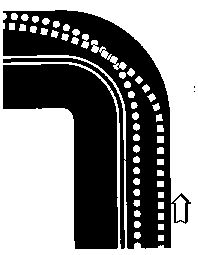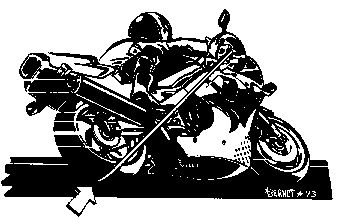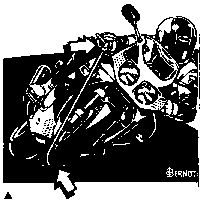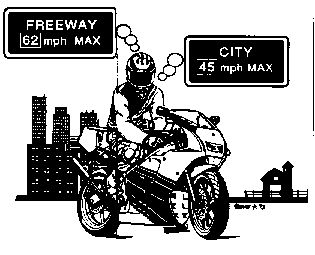
|
||||||||
| home news events club files gallery shop | ||||||||
|
|
||||||||
|
|
|
The Pace
On the racetrack the rider would have tumbled into the hay bales, visited the
ambulance for a strip of gauze and headed back to the pits to straighten his
handlebars and think about his mistake. But let's get one thing perfectly clear:
the street is not the racetrack. Using it as such will shorten your riding
career and keep you from discovering the Pace. The Pace is far from street
racing — and a lot more fun.
The Pace places the motorcycle in its proper role as the controlled vehicle,
not the controlling vehicle. Too many riders of sport bikes become baggage when
the throttle gets twisted — the ensuing speed is so overwhelming they are
carried along in the rush. The Pace ignores outright speed and can be as much
fun on a Ninja 250 as on a ZX-11, emphasizing rider skill over right-wrist
bravado. A fool can twist the grip, but a fool has no idea how to stop or turn.
Learning to stop will save your life; learning to turn will enrich it. What
feels better than banking a motorcycle over into a corner?
The mechanics of turning a motorcycle involve pushing and/or pulling on the
handlebars; while this isn't new information for most sport riders, realize that
the force at the handlebar affects the motorcycle's rate of turn-in. Shove hard
on the bars, and the bike snaps over; gently push the bars, and the bike lazily
banks in. Different corners require different techniques, but as you begin to
think about lines, late entrances and late apexes, turning your bike at the
exact moment and reaching he precise lean angle will require firm, forceful
inputs at the handlebars. If you take less time to turn your motorcycle, you can
use that time to brake more effectively or run deeper into the corner, affording
yourself more time to judge the corner and a better look at any hidden
surprises. It's important to look as far into the corner as possible and
remember the adage, "You go where you look."
We've all rushed into a corner too fast and experienced not just the terror
but the lack of control when trying to herd the bike into the bend. If you're
fighting the brakes and trying to turn the bike, any surprise will be impossible
to deal with. Setting your entrance speed early and looking into the corner
allows you to determine what type of corner you're facing. Does the radius
decrease? Is the turn off- camber? Is there an embankment that may have
contributed some dirt to the corner?
Racers talk constantly about late braking, yet that technique is used only to
pass for position during a race, not to turn a quicker lap time. Hard braking
blurs the ability to judge cornering speed accurately, and most racers who rely
too heavily on the brakes find themselves passed at the corner exits because
they scrubbed off too much cornering speed. Additionally, braking late often
forces you to trail the brakes or turn the motorcycle while still braking. While
light trail braking is an excellent and useful technique to master, understand
that your front tire has only a certain amount of traction to give.
If you use a majority of the front tire's traction for braking and then ask
it to provide maximum cornering traction as well, a typical low-side crash will
result. Also consider that your motorcycle won't steer as well with the fork
fully compressed under braking. If you're constantly fighting the motorcycle
while turning, it may be because you're braking too far into the corner. All
these problems can be eliminated by setting your entrance speed early, an
important component of running the Pace. Using all of the available lane while entering the corner (square
line) provides a number of benefits. It allows you to brake while upright,
see farther through the corner and use a later corner apex. With a later
apex, you can get on the throttle earlier as you stand the bike up out of
the corner. The low entrance line (dotted line) forces you to lean over even
after the apex and is a major contributing factor to overshooting a corner.
Always give the centerline some room; stay right except to pass.
Since you aren't hammering the brakes at every corner entrance, your
enjoyment of pure cornering will increase tremendously. You'll relish the
feeling of snapping your bike into the corner and opening the throttle as early
as possible. Racers talk about getting the drive started, and that's just as
important on the street. Notice how the motorcycle settles down and simply works
better when the throttle is open? Use a smooth, light touch on the throttle and
try to get the bike driving as soon as possible in the corner, even before the
apex, the tightest point of the corner. If you find yourself on the throttle
ridiculously early, it's an indication you can increase your entrance speed
slightly by releasing the brakes earlier.
As you sweep past the apex, you can begin to stand the bike up out of the
corner. This is best done by smoothly accelerating, which will help stand the
bike up. As the rear tire comes off full lean, it puts more rubber on the road,
and the forces previously used for cornering traction can be converted to
acceleration traction. The throttle can be rolled open as the bike stands up.
A tire has a given amount of traction that can be used for
cornering, accelerating, decelerating or a combination of these. A tire
that's cornering hard won't have much traction left for acceleration or
deceleration. Imagine a linkage connecting your rear tire to your throttle
hand. As the tire stands up from full lean, your throttle can be rolled
open; the tire's traction used for cornering can now be converted to
acceleration traction.
This magazine won't tell you how fast is safe; we will tell you how to go
fast safely. How fast you go is your decision, but it's one that requires
reflection and commitment. High speed on an empty four-lane freeway is against
the law, but it's fairly safe. Fifty-five miles per hour in a canyon may be
legal, but it may also be dangerous. Get together with your friends and talk
about speed. Set a reasonable maximum and stick to it. Done right, the Pace is
addicting without high straightaway speeds.
The group I ride with couldn't care less about outright speed between
corners; any gomer can twist a throttle. If you routinely go 100 mph, we hope
you routinely practice emergency stops from that speed. Keep in mind outright
speed will earn a ticket that is tough to fight and painful to pay; cruising the
easy straight stuff doesn't attract as much attention from the authorities and
sets your speed perfectly for the next sweeper. Using your brakes entering a corner, or trail braking, takes a
delicate touch on the lever. As the bike leans in and the tire begins
cornering in earnest, there won't be much traction left for braking. Imagine
a connection between the front-brake lever and the front tire: as the tire
goes to full lean, all traction will be used for cornering; grabbing the
front brake at this point will lock the front wheel.
It's the group aspect of the Pace I enjoy most, watching the bikes in front
of me click into a corner like a row of dominoes, or looking in my mirror as my
friends slip through the same set of corners I just emerged from.
Because there's a leader and a set of rules to follow, the competitive aspect
of sport riding is eliminated and that removes a tremendous amount of pressure
from a young rider's ego — or even an old rider's ego. We've all felt the tug of
racing while riding with friends or strangers, but the Pace takes that away and
saves it for where it belongs: the racetrack. The racetrack is where you prove
your speed and take chances to best your friends and rivals. Riding fast everywhere hurts our image, your license and eventually
your bike and body. Set realistic freeway and city speed limits, stick to
them and save the speed for the racetrack or dragstrip.
I've spent a considerable amount of time writing about the Pace (see
Motorcyclist, Nov. '91) for several reasons, not the least of which being the
fun I've had researching it (continuous and ongoing). But I have motivations
that aren't so fun. I got scared a few years ago when Senator Danforth decided
to save us from ourselves by trying to ban superbikes, soon followed by
insurance companies blacklisting a variety of sport bikes. I've seen Mulholland
Highway shut down because riders insisted on racing (and crashing) over a short
section of it. I've seen heavy police patrols on roads that riders insist on
throwing themselves off of. I've heard the term "murder-cycles" a dozen times
too many. When we consider the abilities of a modern sport bike, it becomes
clear that rider technique is sorely lacking.
The Pace emphasizes intelligent, rational riding techniques that ignore
racetrack heroics without sacrificing fun. The skills needed to excel on the
racetrack make up the basic precepts of the Pace, excluding the mind-numbing
speeds and leaving the substantially larger margin for error needed to allow for
unknowns and immovable objects. Our sport faces unwanted legislation from
outsiders, but a bit of throttle management from within will guarantee our
future. THE PACE PRINCIPLES
|
home ![]() news
news ![]() events
events ![]() club files
club files ![]() gallery
gallery ![]() shop
shop ![]() calendar
calendar ![]() sponsors
sponsors ![]() ride routes
ride routes ![]() "the dezzies"
"the dezzies" ![]() links
links ![]() member profiles
member profiles ![]() contact us
contact us ![]() site map
site map
![]()
Copyright © 2006 DESMO - DESMO and desmoducati.org are not affiliated with Ducati North America or Ducati SpA



